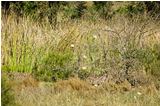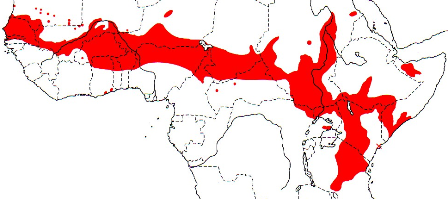Weaver species
Choose different species from drop-down list and press 'Go' button. See Full species list.Vitelline Masked Weaver Ploceus vitellinus
IUCN: Least concern Discovery: 031Categories: acacias, nectar, pest, Nest use,
News items about species
Discovery
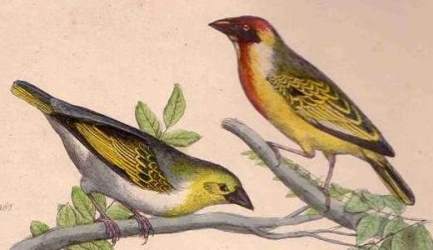
(as Ploceus sublarvatus), figure from Reichenbach 1863 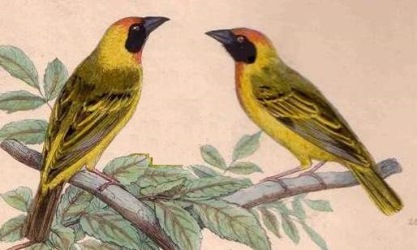
(as Ploceus vitellinus), figure from Reichenbach 1863 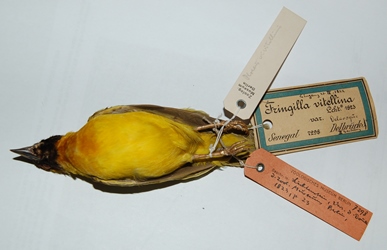
type specimen (ZMB_7298) 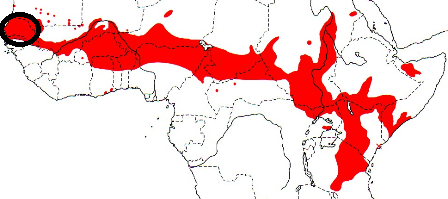
distribution, type locality circled IntroductionThe Vitelline Masked Weaver was formally described by Martin Lichtenstein, a German physician and explorer, who was appointed as director of the Berlin Zoological Museum from 1813.Lichtenstein wrote a brief description in Latin for the Vitelline Masked Weaver, and noted its origin as Senegambia. He did not mention the collector, but two type specimens are in the Berlin Museum of Natural History, and the labels list Delbruck, a German collector. Lichtenstein listed 3 specimens, but one was sold to (or exchanged with) the museum in Vienna (Pelzeln 1887). Although Lichtenstein often sold or exchanged duplicate specimens before adequately describing them, he made the Berlin Museum one of the most active ornithological research centres in Europe. The first illustration of a Vitelline Masked Weaver is a colour painting by Muller 1854 (but I do not have a copy of this). The next illustration is a set of birds painted in colour by Reichenbach (1863). Scientific citationFringilla vitellina Lichtenstein 1823 Verz. Doubl., p.23 Senegambia.Meaning of namesvitellinus Med. Latin: vitellinus, a deep yellow colour tinged red (Latin: vitellus, egg-yolk).First English nameRufous crowned Weaver (Swainson 1837), referring to the orange tinge on the crown.Alternate namesBlack-faced Weaver, Kenya Vitelline Masked Weaver, Rufous crowned Weaver.CollectorDelbruck.Date collectedBefore 1823.Locality collectedSenegambia.Type specimensTwo syntypes are in the Berlin Museum and one in the Vienna Museum. |
The above is based on Weaver Wednesday 2, a weekly series about the discovery of each weaver species.
This species text first appeared as
Weaver Wednesday [148] - Discovery [31]: Vitelline Masked Weaver on 2015-04-15
1. Basic biology
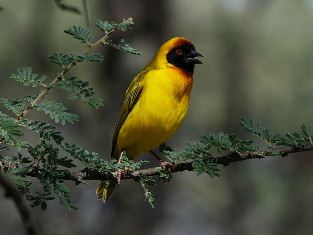
figure from wikipedia Identification. The Vitelline Masked Weaver is a common weaver from West to East Africa. It is very similar to the Southern Masked Weaver and has been been considered a subspecies of the latter as the two species do not overlap in range. The male Vitelline Masked Weaver in breeding plumage has a black mask, bright yellow underparts and a red eye. The bill and mask are smaller than in other masked weavers and the mask is neatly rounded on the throat. The female and non-breeding male are olive above and yellow below, with a reddish eye.
Distribution. The Vitelline Masked Weaver is found from SW Mauritania across the West African savanna belt to Kenya and Tanzania (see map right, based on Birds of Africa). P. v. uluensis (from Ethiopia south to Tanzania) was recognised until recently but due to considerable individual plumage variation the species is now considered monotypic. The Vitelline Masked Weaver has been introduced to a bird park near the Yarkon River, Tel Aviv, Israel. Habitat. The Vitelline Masked Weaver inhabits dry savanna woodland and scrubland in the sahel belt and similar semi-arid regions. It roosts in Acacia trees with other weaver species, and forms nomadic flocks in the non-breeding season. Food. It feeds on seeds and insects; and it also takes the nectar of Leonotis nepetifolia by biting a flower off at the base, mandibulating it to extract the nectar, and then discarding it. On the ground it moves mainly by hopping and it can move rapidly sideways along a branch.
Breeding. The Vitelline Masked Weaver is polygynous and colonial, but is not found in large colonies. Typically it occurs in small groups of nests with a single male in attendance. Its nest is oval to pear-shaped, with the entrance below and a high lip inside. It is tightly woven, and has a very short entrance tunnel or none at all. The nest has a ceiling made of grass heads of 2-3 different kinds while the floor is lined with softer grass heads. Nests are suspended from a single central point of attachment; sited 2-5 m above the ground along or near the tip of a pendulous branch; and often far from water. The male removes nearly all the leaves around a nest. In dry country it often nests in trees over a pool in a garden or desert oasis. The nest usually has broad blades wrapped around the nest, giving it a distinctive look.
The egg colours vary widely as is the case with Southern Masked Weaver eggs. A great sequence of photos of a male building a nest may be seen here. |
The above is based on Weaver Wednesday, a weekly series about weaver species.
This species text first appeared as
Weaver Wednesday [48]: Vitelline Masked Weaver on 2013-05-15
2. Breeding facts
| Pair bond Polygynous Breeding season Mar on coast and Sept-Oct along river in Mauritania, Jul-Oct in Senegal, Gambia and Mali, Jun-Sept in Burkina Faso, Apr-Sept in Ghana, Aug in Togo, Jun-Sept in Nigeria, Niger and DRCongo, Feb-May in Ethiopia, Jun-Aug in Uganda (no recent records), Jul-Jul, Sept and Nov-Dec in Somalia, mainly Mar-May (also Jul-Aug, Nov-Feb) in Kenya, and Jan-Jun in Tanzania Nest site suspended from single point of attachment, in Kenya over water but elsewhere often in tree far from water, 2-5 m above ground Nest building woven by male Colony size Solitary or, often, a small group of nests with single male in attendance, never in large colonies Clutch size 2-4 eggs (average 2.4 in Nigeria) Egg colour blue-white, white (tinged with pink) or greenish, white eggs sometimes with fine black spotting, others with red or violet flecks (either large and sparse, or fine and dense) Egg size average size of 17 eggs 19.5 x 13.2 mm (Nigeria) Incubation incubation by female, period 12-13 days Chicks and nestling period nestling period 14-16 days |
Breeding information based on Handbook of the Birds of the World, Vol. 15.
3. Photos of Weaver Nests
 Vm 30921 |  Vm 30365 |  Vm 30364 |  Vm 30176 | 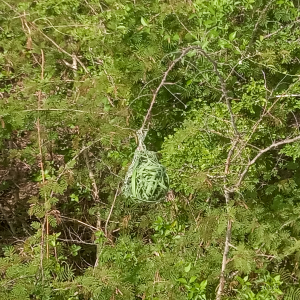 Vm 30031 | 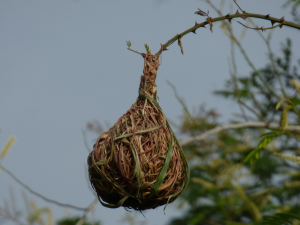 Vm 29538 |
Thumb-nails of most recent PHOWN records - click on one to see its full record
See all PHOWN records for this species here.
PHOWN (Photos of Weaver Nests) provides valuable info on breeding distribution and colony sizes of weavers.
You can contribute by registering and submitting photos at Virtual Museum webpage.
4. Breeding distribution
Google map showing distribution (For species with small ranges you need to zoom in at the correct area to see the range):
yellow blob - range of weaver species; read more about this here.
![]() - PHOWN records with photos
- PHOWN records with photos
![]() - PHOWN records with no photos (Nest Record Cards, other records)
- PHOWN records with no photos (Nest Record Cards, other records)
![]() - Birdpix records
- Birdpix records
![]() - comments on out of range records, or interesting records
- comments on out of range records, or interesting records
![]() - type locality
- type locality
CLICK on the marker on the map to see individual record details.
5. Range changes
Not South African speciesThe above is based on Weaver Wednesday 3, a weekly series about range changes in South African weaver species.
This species text first appeared as
n/a








